
REPRINTS

Exciting news for local historians - on May 22, 2009, the National Park Service approved placing the
Case Brothers Historic District on the National Register of Historic Places. The State of Connecticut had approved the nomination on May 6, 2009.
The district is in the Highland Park area of Manchester, in the southeast corner of town, and includes the town's
640-acre Case Mountain Recreation Area, with old carriage paths, stone walls, bridges, trails and watershed.
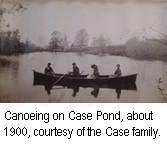
Other property includes three mansions, a rustic lodge, a reservoir, pond, dam, and mills formerly owned by Case family
members.The Upper Case Pond and Case Parklet (near the Spring Street trailhead), and other parcels are owned by the
Manchester Land Conservation Trust. Private owners and trusts own the balance of the property.
Manchester already has nine listings on the National Register, including the Cheney Brothers silk mills, Downtown, Pitkin
Glassworks, Union Village, and the Woodbridge farmstead at Manchester Green.
Click approved nomination form to read more.
Property on the register has certain favorable tax provisions, and also qualifies for federal grants for historic
prservation when money is available. National register listings do not carry the restrictions that local historic districts
may impose, such as pre-approval of house additions and regulations about appearance and remodeling. For example, in the
historic area of Farmington, homeowners must submit a "certificate of appropriateness" for remodeling and building plans to
the Farmington Historic District Commission for approval before they can begin construction.
The district encompasses the remaining paper-mill buildings that the Case Brothers built and operated. The mills were
well known in the paper-manufacturing industry. A. Wells Case held several patents and invented paper-making machinery, a
marine propeller, and a railroad-car coupling, as well as improved methods of making paper.
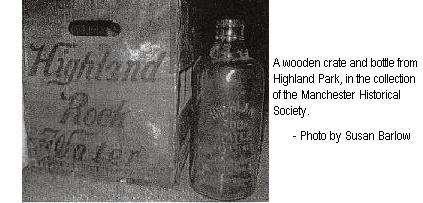
The Case family established the Tonica Springs water-bottling plant, with an international distribution of "Highland
Rock Water" and mineral water. The family was also known for opening its vast wilderness land to the public for hiking,
picnicking, blueberry-picking, and ice-skating. They established a community club in the former bottling works building
and provided summer camp for Highland Park children.
Rachel Carley, a historic preservation consultant from Litchfield, was engaged by the town using Community Development
Block Grant funds to research and write about the disistrict, using the official U.S. Department of the Interior/National
Park Service "National Register of Historic Places Registration Form," a large and detailed document requiring protographs,
text, and a map.
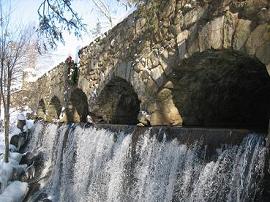
In describing the bridge at Case Pond, visible at the waterfall along Spring Street, Ms. Carley wrote, "The vaulted
bridge ... is a rare example of a Connecticut bridge designed to incorporate a dam as part of the same structure. The
rubblestone construction of these features displays a high quality of craftsmanship and a sensitivity to a woodland
environment shaped by the Cases in the spirit of the romantic landscape ideal of the late Victorian era. Although the
Cases employed judicious trimming to clear paths and views, the effort was deliberately unobtrusive so as to suggest the
hand at work was that of Mother Nature alone." The bridge [shown here] is featured on the home page of Manchester's town
web site.
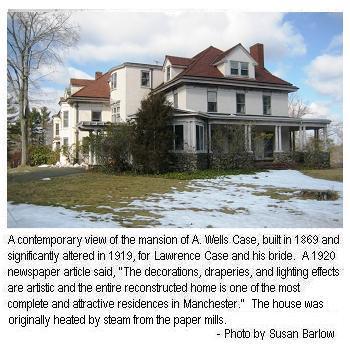 Regarding the A. Wells Case house, on the west side of Spring Street, Ms. Carley said, "This dignified, amply
proportioned residence occupies an open, elevated site ... The style is eclectic, with a strong Mediterranean Revival
flavor ... The walls are finished with pale pink stucco. The hipped roof, distinguished by deep, overhanging eaves, is
clad in red clay shingles ... The structure's basic footprint and massing and the distinctive rubblestone porch (modified
with Tuscan columns) survive from the 1869 house's original incarnation as an Italianate villa."
Regarding the A. Wells Case house, on the west side of Spring Street, Ms. Carley said, "This dignified, amply
proportioned residence occupies an open, elevated site ... The style is eclectic, with a strong Mediterranean Revival
flavor ... The walls are finished with pale pink stucco. The hipped roof, distinguished by deep, overhanging eaves, is
clad in red clay shingles ... The structure's basic footprint and massing and the distinctive rubblestone porch (modified
with Tuscan columns) survive from the 1869 house's original incarnation as an Italianate villa."
There is such a lot of information in the form - historical, cultural, and architectural - and it is fascinating to
those who enjoy this interesting section of town. It is designed for review by preservationists and does contain the
jargon of architectural history, not all of which is familiar to the layperson. For example, page six of section seven
describes the house of A. Willard Case - he was A. Wells Case's twin brother and lived across the street - "The design
exhibits a characteristically lively silhouette accentuated by distinctly triangular gables, which are framed by deep
raking cornices and pitched at varying degrees. The main portion of the asymmetrically massed building is a rectangular,
peak-roofed block, which incorporates and partially absorbs a central hipped-roofed section." Even if you don't know what
"raking cornices" are, you can still get a sense of the complexity and flamboyance of the house's design. By the way, the
raking cornice or rake board is the sloping cornice that's near the roofline of the gables.
Ms. Carley concluded in the nomination form, "The area's seclusion and its striking, rugged toopgraphy combine with the
beauty of the Case family mansions, park, carriage-drive system, and reservoir to establish a distinctive sense of place
in Highland Park. The buildings and landscape offer insight into a significant facet of Connecticut's manufacturing
history and a valuable glimpse into Victorian-era tastes for recreation and leisure pursuits."
The preservation hearing took place on March 12 [2009] at the office of the Commission on Culture and Tourism at
Constitution Plaza in Hartford. The board vote was eight in favor and one abstention. They base their approval of register
nominations on whether the site:
• "Is associated with events that have made a significant contribution to the broad patterns of our history.
• Is associated with the lives of persons significant in our past.
• Embodies the distinctive characteristics of a type, period or method of construction or represents the work of
a master, or possesses high artistic values, or represents a significant distinguishable entity whose components lack
individual distinction.
• Has yielded, or is likely to yield, information important in prehistory or history."
The preservation board heard public comments - two people spoke against, three spoke for, and the preservation
consultant spoke in favor as well. The board made additional comments and suggestions about the nomination form,
including a suggestion to add more information about Native American activity in the area and to look for evidence of
who designed the landscapes in the Case Mountain wilderness area.
Ms. Carley answered questions on the choice of the boundary for the district. Even though the village of Highland
Park originally included the post office and general store at the corner of Spring and Highland streets and the fields
between Glen Road and Highland Street, the construction of I-384 cut off that area from the rest of the historic
structures. Worker houses remain along Highland Street, but were not included within the proposed boundary, despite
their historic interest.
Having the district on the national register recognizes the importance of Manchester in 19th and
early 20th century manufacturing, inventiveness, and philanthropy.
Susan Barlow is a member emerita of the board of directors of the Manchester Historical Society.
~ ~ ~ ~ ~ ~ ~ ~ ~ ~ ~ ~ ~ ~ ~ ~ ~ ~ ~ ~ ~ ~ ~ ~ ~ ~ ~ ~ ~ ~ ~ ~ ~ ~ ~ ~ ~ ~ ~ ~ ~ ~ ~ ~ ~ ~ ~ ~ ~ ~ ~ ~ ~ ~
Manchester Historical Society member Marcia Krafjack, high school class of 1955, recalls living in Case Brothers' employee housing until she was five years old. Her father took another job at that point and the family moved. She recalls the community club near the spring, which we illustrate with these photos, the first two provided by Frank Grimason, grand-nephew of photographer John Knoll, and one provided by the Case family. The building started out as the Case Brothers' water-bottling plant, later becoming a clubhouse and YMCA before an arsonist burned it to the ground in the early 1940s. Click each photo to get a larger view.
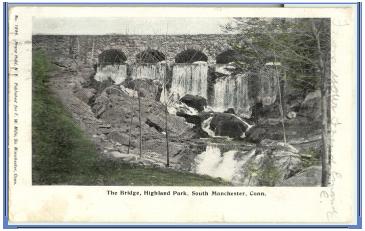
All content copyright 2025, Manchester Historical Society, founded 1965. All rights reserved.